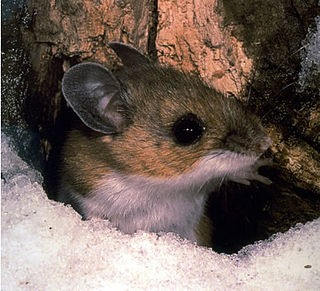
The Neotominae are a subfamily of the family Cricetidae. They consist of four tribes, 16 genera, and many species of New World rats and mice, predominantly found in North America. Among them are the well-known deer mice, white-footed mice, packrats, and grasshopper mice.

Isla Todos Santos is a pair of islands about 19.3 km (12.0 mi) off Ensenada, Baja California, at 31°47′59″N116°47′20″W best known for surfing. Access is only by boat, which can be rented in Ensenada, or La Bufadora. The waves off the smallest island are among the biggest in North America. There are no facilities on the islands except for two lighthouses and a fish farm operation.

The eastern woodrat, also known as the Florida woodrat or bush rat is a pack rat native to the central and Eastern United States. It constructs large dens that may serve as nests for many generations and stores food in outlying caches for the winter. While widespread and not uncommon, it has declined or disappeared in several areas.

The Mexican woodrat is a medium-sized pack rat.
The Tamaulipan woodrat is a species of rodent in the family Cricetidae. It is found only in Mexico.
Bryant's woodrat is a species of new-world rodent in the family Cricetidae native to the Southwestern United States and Mexico.
Bunker's woodrat is an extinct subspecies of Bryant's woodrat in the family Cricetidae. Only five specimens are known; these were collected in 1932 by W.H. Burt and are housed at a museum at UCLA. Neotoma bunkeri was only described from Coronados Islands, Baja California, Mexico. It probably died out as a result of depletion of food resources and predation by feral cats.
The Nicaraguan woodrat is a species of rodent in the family Cricetidae found in Honduras and Nicaragua.

The bushy-tailed woodrat, or packrat is a species of rodent in the family Cricetidae found in Canada and the United States. Its natural habitats are boreal forests, temperate forests, dry savanna, temperate shrubland, and temperate grassland.
The Arizona woodrat is a species of rodent in the family Cricetidae. It is found in Mexico and United States.

Goldman's woodrat is a rodent species in the family Cricetidae. It is found only in Mexico throughout the Mexican Plateau, stretching from Southeast Chihuahua to South San Luis Potosi and North Queretaro. The plateau is an average 5,988 ft. above sea level and covers a land area of 232,388 sq. miles.
The San Martín Island woodrat is an extinct subspecies of Bryant's woodrat in the family Cricetidae.

The Southern Plains woodrat is a species of rodent in the family Cricetidae. It is found in northwest Mexico and in Colorado, Kansas, New Mexico, Oklahoma, and Texas in the United States.
Nelson's woodrat is a species of rodent in the family Cricetidae. It is endemic to Mexico, where it is known only from the eastern slopes of the volcanoes Orizaba and Cofre de Perote. Due to the small geographic range, isolation, and low population, the Nelson's woodrat has a higher risk for extinction. The distribution and population sizes are small. The population exists in geographic isolation, which prevents gene flow
The Bolaños woodrat is a species of rodent in the family Cricetidae found only in Mexico.
The Sonoran woodrat is a species of rodent in the family Cricetidae found only in Mexico.
Stephen's woodrat is a species of rodent in the family Cricetidae found in Arizona, New Mexico and Utah in the United States.
Neotoma leucodon is a species of rodent in the family Cricetidae. Although originally named from San Luis Potosí, Mexico, as a species by Merriam, the white-toothed woodrat was long considered to be a synonym of the white-throated woodrat. Molecular data, however, indicate the populations east of the Rio Grande in New Mexico and Trans-Pecos Texas represent a different species than morphologically similar populations west of the river.

The big-eared woodrat is a nocturnal rodent of the woodrat genus Neotoma, in the family Cricetidae. Closely related to, and formerly included in the species Neotoma fuscipes, it is endemic to western North America and occurs west and south of the Salinas Valley from the California Coast Ranges south of Monterey Bay to northern Baja California, as well as in the Sierra Nevada mountains, extending north to the South Fork American River.

A pack rat or packrat, also called a woodrat or trade rat, can be any of the species in the rodent genus Neotoma. Pack rats have a rat-like appearance, with long tails, large ears, and large, black eyes. Pack rats are noticeably larger than deer mice, harvest mice, and grasshopper mice, and are usually somewhat larger than cotton rats.









